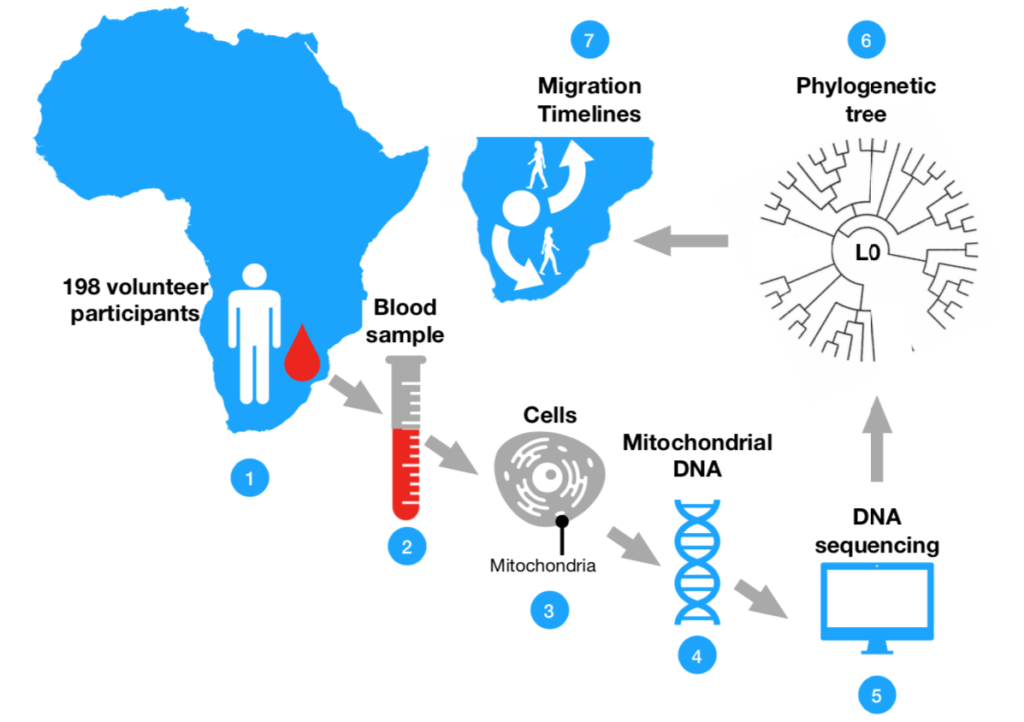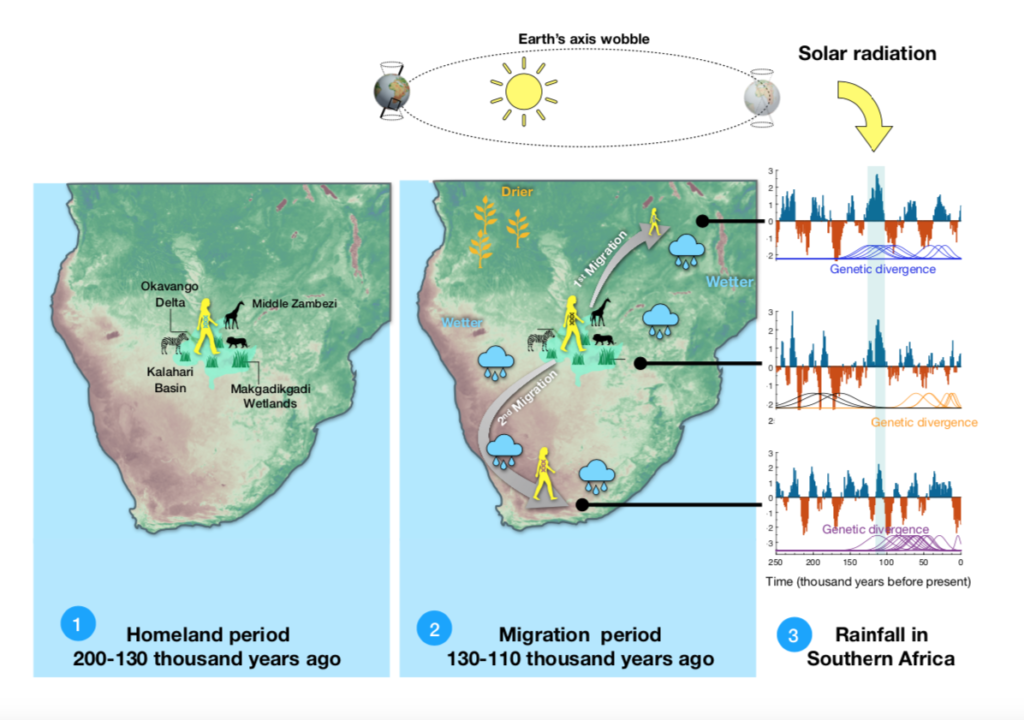A landmark study pinpoints the birthplace of modern humans in southern Africa and suggests how past climate shifts drove their first migration.
A study has concluded that the earliest ancestors of anatomically modern humans (Homo sapiens sapiens) emerged in a southern African ‘homeland’ around 200 thousand years ago and thrived there for 70 thousand years, until changes in Africa’s climate triggered the first human exploration. This migration event contributed to the development of humans’ genetic, ethnic and cultural diversity as we know it today.
The breakthrough findings were published in this week’s issue of the journal Nature.
DNA as a time capsule for early human history
“It has been clear for some time that anatomically modern humans appeared in Africa roughly 200 thousand years ago. What has long been debated is the exact location of this emergence and subsequent dispersal of our earliest ancestors,” says study lead Professor Vanessa Hayes from the Garvan Institute of Medical Research and University of Sydney, and Extraordinary Professor at the University of Pretoria.
“Mitochondrial DNA acts like a time-capsule of our ancestral mothers, accumulating changes slowly over generations. Comparing the complete DNA code, or mitogenome, from different individuals provides information on how closely they are related.”
In their study, Professor Hayes and her colleagues collected blood samples to establish a comprehensive catalogue of modern human’s earliest mitogenomes from the so-called ‘L0’ lineage. “Our work would not have been possible without the generous contributions of local communities and study participants in Namibia and South Africa, which allowed us to uncover rare and new L0 sub-branches,” says study author and public health Professor Riana Bornman from the University of Pretoria.
“Merging 198 new, rare mitogenomes to the current database allowed us to refine the evolutionary tree of our earliest ancestral branches better than ever before,” says first author Dr Eva Chan from the Garvan Institute of Medical Research, who led the phylogenetic analyses.
By combining the L0 lineage timeline with the linguistic, cultural and geographic distributions of different sub-lineages, the study authors revealed that 200 thousand years ago, the firstHomo sapiens sapiensmaternal lineage emerged in a ‘homeland’ south of the Greater Zambezi River Basin region, which includes the entire expanse of northern Botswana into Namibia to the west and Zimbabwe to the east.
A homeland perfect for life to thrive
Investigating existing geological, archeological and fossil evidence, geologist Dr Andy Moore, from Rhodes University, revealed that the homeland region once held Africa’s largest lake system, Lake Makgadikgadi.
“Prior to modern human emergence, the lake had begun to drain due to shifts in underlying tectonic plates. This would have created, a vast wetland, which is known to be one of the most productive ecosystems for sustaining life,” says Dr Moore.
Modern humans’ first migrations
The authors’ new evolutionary timelines suggest that the ancient wetland ecosystem provided a stable ecological environment for modern humans’ first ancestors to thrive for 70 thousand years.
“We observed significant genetic divergence in the modern humans’ earliest maternal sub-lineages, that indicates our ancestors migrated out of the homeland between 130 and 110 thousand years ago,” explains Professor Hayes. “The first migrants ventured northeast, followed by a second wave of migrants travelling southwest. A third population remained in the homeland until today.”
“In contrast to the northeasterly migrants, the southwesterly explorers appear to flourish, experiencing steady population growth,” says Professor Hayes. The authors speculate that the success of this migration was most likely a result of adaptation to marine foraging, which is further supported by extensive archaeological evidence along the southern tip of Africa.
Climate effects
To investigate what may have triggered these early human migrations, Professor Axel Timmermann and Dr. Sun-Seon Lee from the IBS Center for Climate Physics at Pusan National University analyzed climate supercomputer model simulations and geological data which capture Southern Africa’s climate history of the past 250 thousand years.
“Our simulations suggest that the slow wobble of Earth’s axis changes summer solar radiation in the Southern Hemisphere, leading to periodic shifts in rainfall across southern Africa,” says Professor Timmermann, co-corresponding author of the study and Director of the IBS Center for Climate Physics. “These shifts in climate would have opened green, vegetated corridors, first 130 thousand years ago to the northeast, and then around 110 thousand years ago to the southwest, allowing our earliest ancestors to migrate away from the homeland for the first time.”
“These first migrants left behind a homeland population,” remarks Professor Hayes. “Eventually adapting to the drying lands, maternal descendants of the homeland population can be found in the greater Kalahari region today.”
This study uniquely combined the disciplines of genetics, geology and climatic physics to rewrite our earliest human history.


Notes for editors
– References
JEva K.F. Chan, Axel Timmermann, Benedetta F. Baldi, Andy E. Moore, Ruth J. Lyons, Sun-Seon Lee, Anton Kalsbeek, Desiree C. Petersen, Hannes Rautenbach, Hagen E.A. Förtsch, Riana Bornman. Vanessa M. Hayes. DOI: 10.1038/s41586-019-1714-1
– Media Contact
For further information or to request media assistance, please contact: Kyungmi Park, IBS Center for Climate Physics, Pusan National University (+82-51-510-7750, kyungmi@pusan.ac.kr)
– About the Institute for Basic Science (IBS)
IBS was founded in 2011 by the government of the Republic of Korea with the sole purpose of driving forward the development of basic science in South Korea. IBS has launched 30 research centers as of January 2019. There are nine physics, two mathematics, six chemistry, seven life science, one earth science, and five interdisciplinary research centers.
– About ICCP
The IBS Center for Climate Physics (ICCP) seeks to expand the frontiers of earth system science by conducting cutting edge research into climate dynamics and utilizing high-performance computer simulations, with the goal of improving decadal Earth system forecasts and long-term projections.
- [SABCNews] Humankind’s ancestral ‘homeland’ pinpointed in Botswana
- [ZMEScience] Our earliest ancestors may have originated in southern Africa
- [SBSNews] Australian scientists discover the ancestral home of modern humans
- [ScienceFocus] Modern humans can be traced back near Zambezi River in Botswana, study finds
- [ScienceAlert] New Study Pinpoints The Ancestral Homeland of All Humans Alive Today
- [ScienceDaily] The homeland of modern humans
- [ScienceMag] Experts question study claiming to pinpoint birthplace of all humans
- [SDE] Scientists discover ‘Garden of Eden’ in Africa
- [stuff] Scientists claim to have found birthplace of modern humans
- [TechnologyNetworks] Modern Man’s Hometown Pinpointed
- [Telesur] Humankind’s Ancestral Home Is Botswana: Study
- [10Daily] Humanity’s Birthplace: Why Everyone Alive Today Can Call This Place Home
- [TheAfricanExponent] Scientists Trace Origin of Modern Humans to Botswana
- [TheEveningStandard] Ancestral home of all human beings pinpointed by scientists
- [TheFatuNetwork] Humankind’s Ancestral ‘Homeland’ Pinpointed In Botswana
- [TheGuardian] Ancestral home of modern humans is in Botswana, study finds
- [TheJapanTimes] Modern humanity’s ‘ancestral homeland’ found in Botswana
- [TheTimesofIsrael] New study traces humanity’s ‘homeland’ to ancient Botswana
- [TheAge] A homecoming story for all humanity: Australian scientists claim to have found birthplace of modern
- [TheCeoMagazine] Birthplace of humans pinpointed to northern Botswana
- [TaipeiTimes] Humankind’s ancestral ‘homeland’ pinpointed in Botswana
- [TheScientist] The First Modern Humans Came from What Is Now Botswana: Study
- [TheSun] LIFE ON EARTH Real ‘Garden of Eden’ where ALL humans originated 200,000 years ago finally found in
- [TheWeek] Where was the Garden of Eden? DNA has the answer
- [UP] Groundbreaking study reveals southern Africa as birthplace of modern Homo sapiens, who migrated due
- [UPI] Paleontologists trace orgins of modern humans to Botswana
- [VOA] Humankind’s Ancestral ‘Homeland’ Pinpointed in Botswana
- [WorldTimesNews] HUMANKIND’S ANCESTRAL ‘HOMELAND’ PINPOINTED IN BOTSWANA
- [WQAD] All modern humans originated in northern Botswana, study says
- [Zimeye] Garden Of Eden Was Located In Botswana -Report
- [SaharaReporters] Humans First Appeared In Botswana, Not Tanzania – Study
- [Genomeweb] Mitochondrial DNA Analysis Uncovers Human ‘Homeland’ in Southern Africa
- [GuardianNews] Ancestral home of modern humans is in Botswana, study finds
- [HEADTOPICS] Ancestral homeland of earliest human ancestors traced to Botswana
- [HeraldNigeria] Humankind’s Ancestral ‘Homeland’ Pinpointed In Botswana
- [Hilltopmonitor] Humankind’s ancestral ‘homeland’ pinpointed in Botswana
- [independent] Ancestral home of all human beings discovered by scientists
- [indiatimes] Place Where Humanity Originated Has Finally Been Found, And It’s In A River
- [interestingEngineering] Researchers Place Earliest Modern Humans in Southern Africa
- [inverse] Scientists may have finally pinpointed humanity’s ancestral hometown
- [IOL] Humankind’s ancestral ‘homeland’ pinpointed in Botswana
- [LatestLY] Humanity’s Homeland Found in Ancient Botswana
- [legit] Scientists trace origin of human race to Bostwanna, Africa in new research
- [LiveScience] Scientists Think They’ve Found ‘Mitochondrial Eve’s’ First Homeland
- [macaubusiness] Humanity’s homeland found in ancient Botswana
- [MailOnline] REVEALED: How wobble in the Earth’s axis 130,000 years ago allowed early humans to leave the ‘Garden
- [metro] Ancestral homeland of earliest human ancestors traced to Botswana
- [mirror] Scientists discover ‘Garden of Eden’ where humans originated 200,000 years ago
- [mmegi] Humans originate from Botswana – Scientists
- [NationalGeographic] CONTROVERSIAL NEW STUDY PINPOINTS WHERE ALL MODERN HUMANS AROSE
- [NewAtlas] DNA study claims human
- [NewScientist] Have we found the African origin of all humanity? It’s complicated
- [NewStraitsTimes] Where did humans come from? Botswana
- [news24] Humanity’s homeland found in ancient Botswana
- [NewsClick] Modern Human’s Homeland Is an Ancient Wetland in South Africa, Sas Study
- [NewsGram] Ancestral Homeland of All 7.7 Billion People on Earth Pinpointed in Botswana
- [Newshub] Origins of modern humans pinpointed in study
- [nypost] Modern humans came from Botswana, study says
- [pbs.org] Cradle of modern human life found in Botswana…maybe
- [perthnow] Australian researchers pinpoint location of modern humans’ homeland
- [PHYS.ORG] Humanity’s birthplace: why everyone alive today can call northern Botswana home
- [QuartzAfrica] Scientists now have evidence the evolutionary birthplace of human kind was in northern Botswana
- [Reuters] Humankind’s ancestral ‘homeland’ pinpointed in Botswana
- [RTE] Humankind’s ancestral ‘homeland’ pinpointed in Botswana
- [TheVoiceBW] Study suggests ALL modern humans evolved from ancestors in Botswana
- [FoxNews] Ancestral home of modern humans is in Botswana, scientists find
- [BusinessInsider] Every person alive today descended from a woman who lived in modern-day Botswana about 200,000 years
- [ChinaDaily] Changing African climate pushed first humans to move
- [EbruTV] Humankind’s ancestral ‘homeland’ pinpointed in Botswana
- [TWCIndia] We All Have Come from One Place, and It’s in Botswana: Study
- [ChathamDailyNews] Researchers say they have found the original African ‘homeland’ that nurtured humanity for 70,000 ye
- [4BC] Landmark study pinpoints the birthplace of modern humans
- [ABC] Scientists trace modern humans to a single giant wetland in southern Africa
- [AfricaFeeds] Why Botswana is ancestral homeland of all humans alive
- [alarabiya] Humankind’s ancestral ‘homeland’ pinpointed in Botswana
- [aljazeera] Ancestral homeland of modern humans in Botswana, study finds
- [arstechnica] No, a genetic study didn’t pinpoint the ancestral homeland of all humans
- [BBCNews] Origin of modern humans ‘traced to Botswana’
- [BellaNaija] This Study Says all Modern Humans Originated in Botswana
- [CBC] Humankind’s ancestral ‘homeland’ pinpointed in Botswana
- [CGTN] Humankind’s ancestral ‘homeland’ pinpointed in Botswana
- [ChitralNews] Origin of modern humans ‘traced to Botswana- BBC
- [CNN] All modern humans originated in northern Botswana, study says
- [CypruMail] Humankind’s ancestral ‘homeland’ pinpointed in Botswana
- [DailyHunt] Humankind’s ancestral ‘homeland’ pinpointed in Botswana
- [DailyMaverick] Origins of modern man revealed ? Africa is in us all
- [DailySabah] Humankind’s ancestral ‘homeland’ pinpointed in Botswana
- [DAWN] Humanity’s homeland found in ancient Botswana
- [DeccanChronicle] Humankind’s ancestral ‘homeland’ pinpointed in Botswana
- [DownToEarth] Humanity’s birthplace: why everyone alive today can call northern Botswana home
- [Ecns.cn] Changing African climate pushed first humans to move
- [EurasiaReview] All Modern Humans Originated In Northern Botswana
- [EurekAlert!] The homeland of modern humans
- [EuroNews] Humankind’s ancestral ‘homeland’ pinpointed in Botswana
- [Express] Scientists make major humanity breakthrough in ‘cradle of humankind’ discovery
- [FatuNetwork] Humankind’s Ancestral ‘Homeland’ Pinpointed In Botswana
- [GlobalNews] Modern humans originated from Botswana, but left due to climate change: study